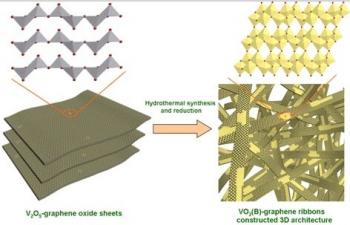Scientists from Rice University developed new ribbons made from vanadium-oxide and graphene-oxide (using a simple hydrothermal process) that make for superior Li-Ion battery cathodes. Batteries that use these new cathodes exhibit high energy and power densities. The new cathodes use materials that are relatively abundant and cheap.

The researchers found out that prototype cathodes used with halfcells can charge and discharge in 20 seconds and retain more than 90% of the capacity after more than 1,000 cycles. Those prototype cathodes were made from 84% VO2 (that hold 204 milliamp hours of energy per gram).
To produce those prototypes, the researchers put graphene oxide sheets together with powdered vanadium pentoxide in water and heated it using an autoclave. The vanadium pentoxide was reduced to VO2, which crystallized into ribbons. The graphene-oxide was reduced to graphene. The ribbons were 10 nanometres thick, up to 600 nanometres wide and tens of micrometers in length.

